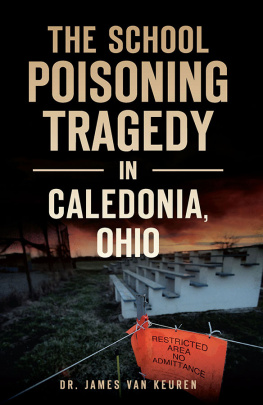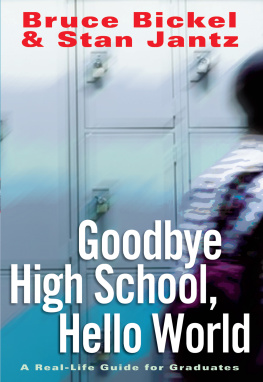

Published by The History Press
Charleston, SC
www.historypress.com
Copyright 2021 by Dr. James Van Keuren
All rights reserved
Cover images courtesy of the Columbus Dispatch.
First published 2021
ebook edition 2021
ISBN 978.1.43967.200.6
Library of Congress Control Number: 2020945746
print edition ISBN 978.1.46714.632.6
Notice: The information in this book is true and complete to the best of our knowledge. It is offered without guarantee on the part of the author or The History Press. The author and The History Press disclaim all liability in connection with the use of this book.
All rights reserved. No part of this book may be reproduced or transmitted in any form whatsoever without prior written permission from the publisher except in the case of brief quotations embodied in critical articles and reviews.
CONTENTS
To the graduates of the River Valley Local School District in Caledonia, Ohio, who battled cancer and were left with a lifetime of pain and suffering, and to those who passed away at such a young age. I believe that the information and the data points presented in the book raise questions about the toxic contamination found throughout the school grounds. This is not a report clouded by scientific and technical jargon, but a presentation of understandable facts that gives the reader the opportunity to judge the validity of the conclusions reached by the government agencies that found no link between the contaminants on the school grounds to the various incidents of cancers among the River Valley High School graduates.
PREFACE
This story begins with the release of my recent book World War II POW Camps in Ohio, which describes in a chapter called Contamination on the Home Front the various former military sites used during World War II in and around Camp Perry, Ohio, especially the Marion Engineer Depot, Marion, Ohio, which were found to be contaminated after their abandonment by the military. One such site was the River Valley Local School District in Caledonia, Ohio. Researching that book triggered my curiosity about the prevalence of contaminated sites across the United States. I discovered from the U.S. Army Corps of Engineers site map that there are 5,144 Formerly Used Defense Sites, including 95 in my home state of Ohio.
I started to speculate whether the communities surrounding the contaminated sites were exposed to toxic waste and whether such exposure contributed to debilitating diseases. In fact, the nationally known contamination sites with high cancer rates include Woburn, Massachusetts, and Toms River, New Jersey, where industrial waste caused contaminated drinking water supplies. Then there is Camp Lejeune, where the drinking water had been contaminated for over thirty years, finally leading to a settlement in which former marines received compensation for their diseases.
I wrote The School Poisoning Tragedy in Caledonia, Ohio to tell the story of a contaminated school district grounds, where questions were asked and data points provided of Examining Historical Evidence, Expanding Community Action & Communication, Defining the Results and Exploring Legal Options that offer a template for Formerly Used Defense Sites, Superfund and other contaminated sites. My aim is that my research will lead us to ask the right questions and to demystify the environmental site investigation results from their technical and scientific jargon so that they can be properly understood and interpreted.
I propose a Health Risk Reimbursement Program for Superfund and Formerly Used Defense Sites to provide a fairness approach for those who can prove that their debilitating diseases were directly caused by the contaminants at those sites and that such a program be retroactively implemented for the afflicted graduates of the River Valley Local School District in Caledonia, Ohio.
ACKNOWLEDGEMENTS
I would like to first thank my wife, Pat, once again, for her patience and encouragement during my lengthy hours of research and writing. To the graduates of River Valley High School, who continue to call into question the liability of the federal government for allowing the sale of contaminated property to the school district and for the graduates strength in enduring years of hardship and debilitating diseases among the community. A special thank-you to the Marion County Public Library, especially librarian Kim Hunsicker, who assisted me in locating archived documents related to environmental site inspections and contamination of the school district grounds. Once again, to the great researchers at the National Archives and Records Administration, without whose assistance I would have been unable to retrieve historical photos for this book. Another thank-you to Mark A. Walters of SandPrint Memoirs & Editing LLC for his editing skills with both this book and my previous books, A Tribute to the 109th Evacuation Hospital Semi-Mobile Unit and World War II POW Camps in Ohio. Appreciation also goes to Bryan Miller at OfficeMax in North Olmsted, Ohio, for assisting in framing the photos.
A special thank you to John Rodrigue and Abigail Fleming of Arcadia Publishing and The History Press, who took me through every phase of the publication process to ensure that we had a quality product that would be appreciated by the reader.
I am grateful for Patrick Patton, a River Valley High School graduate, for his courage in telling of the pain and suffering he has endured with a brain tumor, which he attributes to the contaminated grounds of the school district. In his mind, no one ever cared or listened to the River Valley graduates who suffered like him, often at the hands of money and power. He told me: If someone else out there cares, I havent heard about them yet. I hope my story shows that someone out there cares.
INTRODUCTION
Questions are still being asked today.
The Marion Engineer Depot (MED) was the largest depot of its kind, housed on 650 acres and known for storing and renovating heavy construction equipment, shipped food, supplies and military equipment during World War II. The loading section of the depot that was laid out in four avenues and six streets, comprising twenty-two miles of railroad track. The depot was also the receiver of a Japanese submarine.
The importance of the Marion Engineer Depot to the World War II efforts cannot be overstated. In one month, it loaded 1,544 railroad cars and unloaded 1,231 cars of material and equipment, as records show in May 1945. The facility hit a peak tonnage in May 1943 with 44,000 tons of troop stock shipped to war zones while it received 23,000 tons of equipment and supplies. During the wartime effort, the depot employed 1,400 civilians and held 295 prisoners of war who met the labor demands of the depot.
This was the bright spot in the heyday of the Marion Engineer Depot. The property changed hands in the early 1960s when the River Valley Local School District purchased 78 acres, and they were subsequently used over the years as a middle school, high school and athletic fields. In 1997, to the heartbreak of the graduates and parents, it was discovered that a portion of school property had been contaminated all this time. It was in 1997 when residents of the school district believed that the high rate of leukemia, non-Hodgkins lymphoma and other forms of cancer afflicting the graduates was possibly linked to the former military activities at the depot, especially in and around the athletic fields.
Next page










